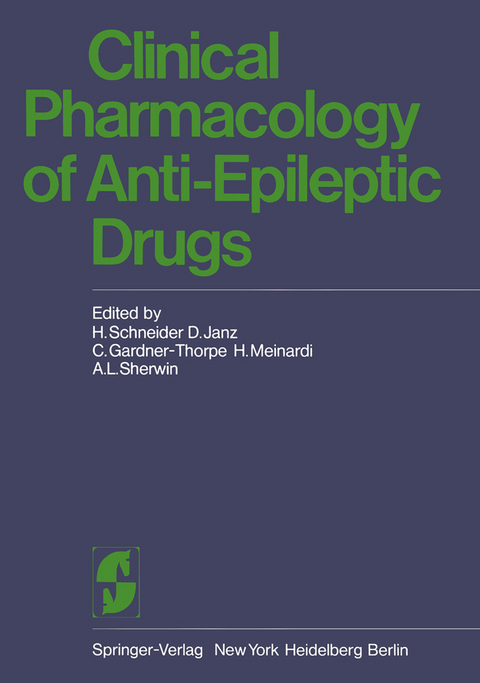
Clinical Pharmacology of Anti-Epileptic Drugs
Springer Berlin (Verlag)
978-3-642-85923-6 (ISBN)
A. Pharmacokinetics.- Statistical Analysis of Pharmacokinetic Parameters in Epileptic Patients Chronically Treated with Anti-Epileptic Drugs.- Clinical Pharmacokinetics in Monitoring Chronic Medication with AntiEpileptic Drugs.- Drug Interactions at the Metabolic Level: A Reality in Drug Treatment of Epilepsy.- General Discussion.- B. Pharmacology of Anti-Epileptic Drugs.- I. Phenytoin.- Comparison of Gas-Chromatographic and Spectrophotometric Determinations of Phenytoin in Serum.- Serum Levels of Phenytoin in Children.- Problems in Controlled Anti-Epileptic Treatment with Phenytoin in Children.- Longitudinal Studies of Serum Anti-Epileptic Drug Levels. Preliminary Observations: Interaction of Phenytoin and Primidone.- Effect of Drug Therapy on the Metabolism of Phenytoin.- General Discussion..- II. Ethotoin.- Plasma Concentrations of Ethotoin in Epileptic Patients.- A Gas Chromatographic Method for the Determination of Ethotoin (3- Ethyl-5-Phenylhydantoin) in Human Plasma.- General Discussion.- III. Barbiturates.- Some Problems Concerning the Quantitative Assay of Primidone and Its Metabolites.- Determination of Hydroxymetabolites of Phenobarbitone and Phenytoin.- The Effect of Psychotropic Drugs on Serum Anti-Epileptic Levels in Psychiatric Patients with Seizure Disorders.- General Discussion.- IV. Carbamazepine.- Carbamazepine: An Attempt to Correlate Serum Levels with Anti-Epileptic and Side Effects.- Pharmacokinetic Data o Pds. Carbamazepine and its Major Metabolites in Man.- Pharmacokinetic Studies on Carbamezepine in Volunteers and in Epileptic Patients.- A Preliminary Study of Serum Carbamazepine Levels in Healthy Subjects and in Patients with Epilepsy.- Carbamazepine: The Influence of Other Anti-Epileptic Drugs on its Serum Level.- Drug Interaction in Epileptic Patients.- The Influence of Phenobarbitone and Phenytoin on Carbamazepine Serum Levels.- General Discussion.- V. Ethosuximide.- Correlation of Serum Ethosuximide Levels with Clinical Effect.- General Discussion.- VI. Dipropylacetate.- Less Usual Ways of Administering Anti-Epileptic Drugs.- Enteric Coated Dipropylacetate (Depakine).- Analytical Data in Connection with the Clinical Use of Di-n-Propylacetate.- General Discussion.- VII. Clonazepam.- Clinical Pharmacokinetic Experiences with Clonazepam.- Pharmacokinetics of Clonazepam in Man and Laboratory Animals.- General Discussion.- C. Various Aspects (Varia).- Absorption and Protein Binding in Serum of Several Anti-Epileptic Drugs.- Phenytoin and Phenobarbitone Levels in Human Brain and Cerebrospinal Fluid..- General Discussion.- D. Quality Control and Standardization.- Report on Worksheets Collected after WODADIBOF I.- Results of a Phenytoin Quality Control Scheme.- The Development of a Matrix Reference Standard for Anti-Epileptic Analysis.- General Discussion.- E. Methodology of Determination.- Comparison of Methods for Determination of Drugs in Serum and Plasma.- Application of a Nitrogen-Specific Detector for the Gas Chromatographic Determination of Phenytoin, Primidone and Phenobarbitone in 20 µl Serum..- Consecutive Determination of the Levels of Twelve Anti-Epileptic Drugs in Blood and Cerebrospinal Fluid.- Evaluation of an Experimental Homogeneous Enzyme Immuno-Assay for the Quantitation of Phenytoin and Phenobarbitone in Serum or Plasma.- General Discussion.- Summing up. C. Gardner-Thorpe.- F. Dictionary of Anti-Epileptic Drug Synonyms, Chemical Names and Nonproprietary Names.- F. Dictionary of Anti-Epileptic Drug Synonyms, Chemical Names and Nonproprietary Names.
| Erscheint lt. Verlag | 4.4.2012 |
|---|---|
| Zusatzinfo | XII, 370 p. |
| Verlagsort | Berlin |
| Sprache | englisch |
| Maße | 170 x 244 mm |
| Gewicht | 667 g |
| Themenwelt | Medizin / Pharmazie ► Allgemeines / Lexika |
| Medizin / Pharmazie ► Medizinische Fachgebiete ► Pharmakologie / Pharmakotherapie | |
| Medizin / Pharmazie ► Pharmazie ► PTA / PKA | |
| Schlagworte | Drug • Kinetics • Pharmacokinetics • pharmacology • Research • Stress |
| ISBN-10 | 3-642-85923-2 / 3642859232 |
| ISBN-13 | 978-3-642-85923-6 / 9783642859236 |
| Zustand | Neuware |
| Haben Sie eine Frage zum Produkt? |
aus dem Bereich


